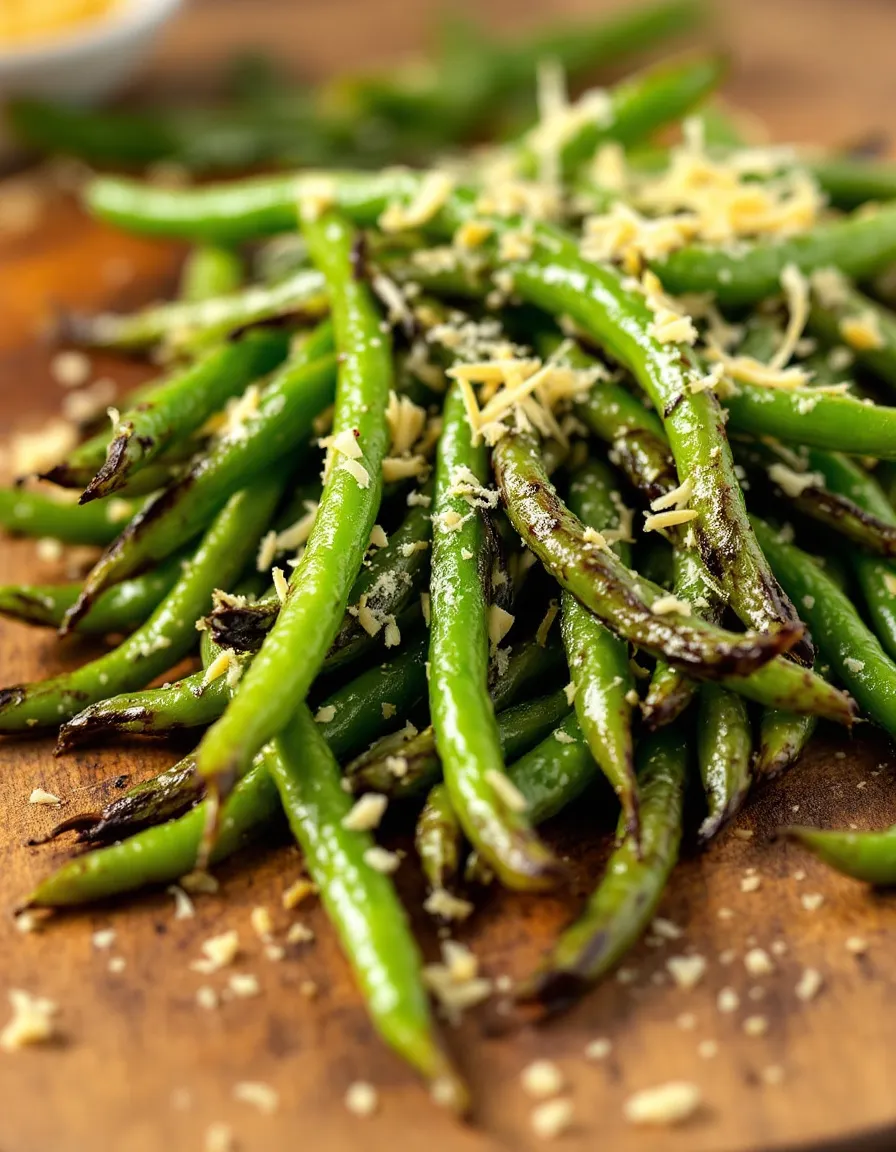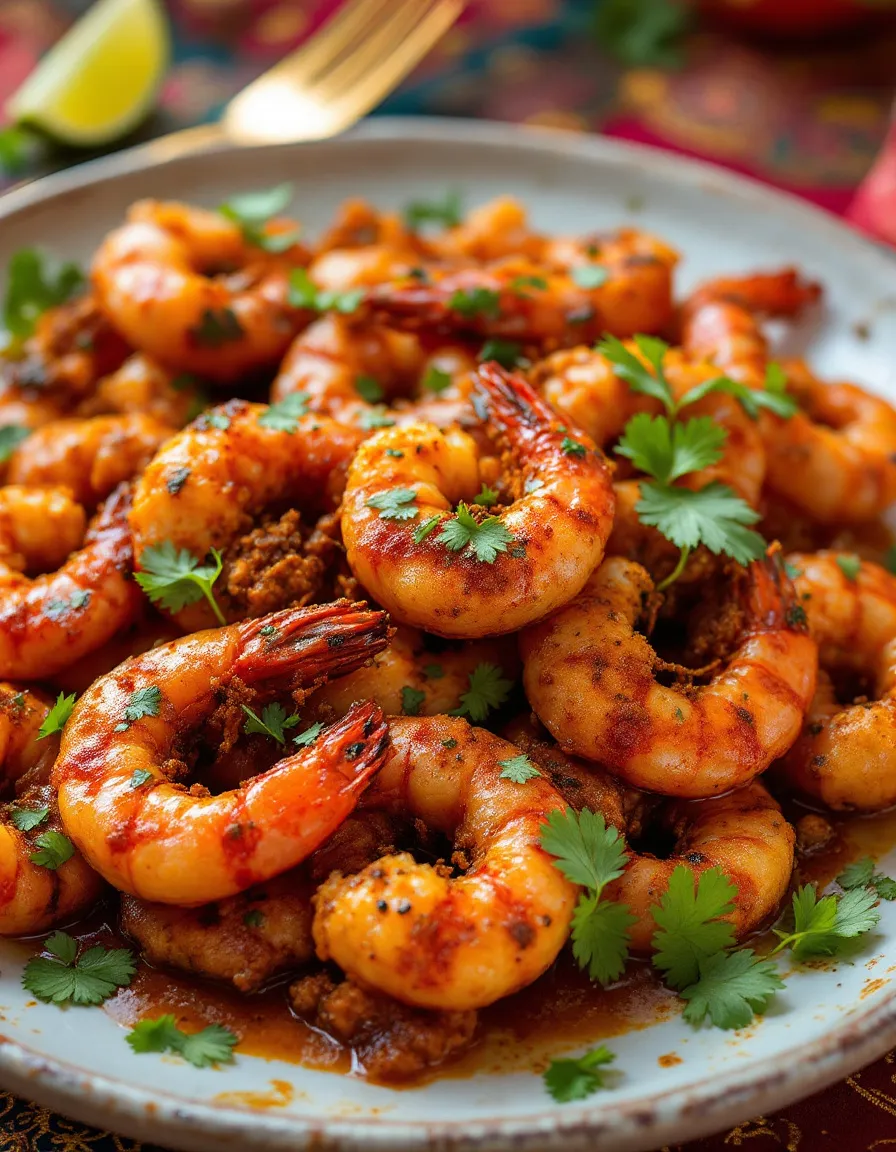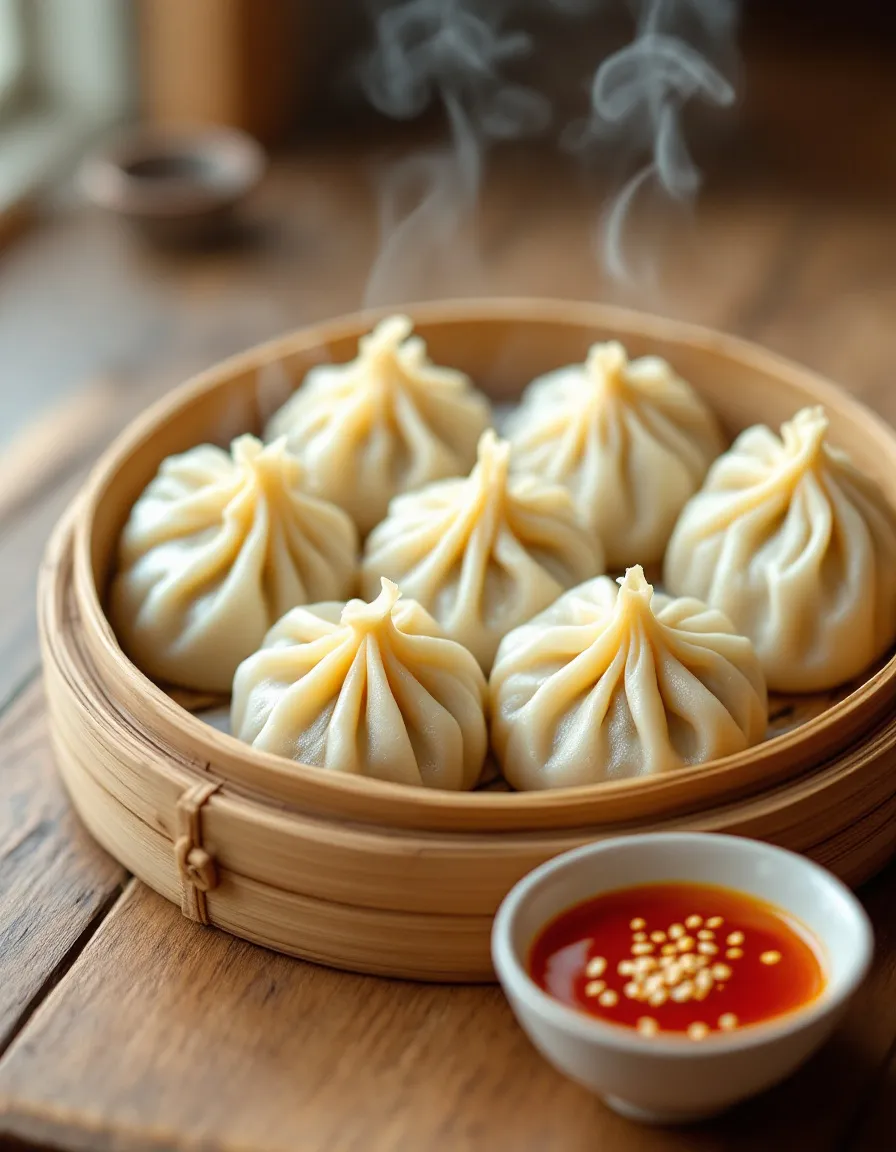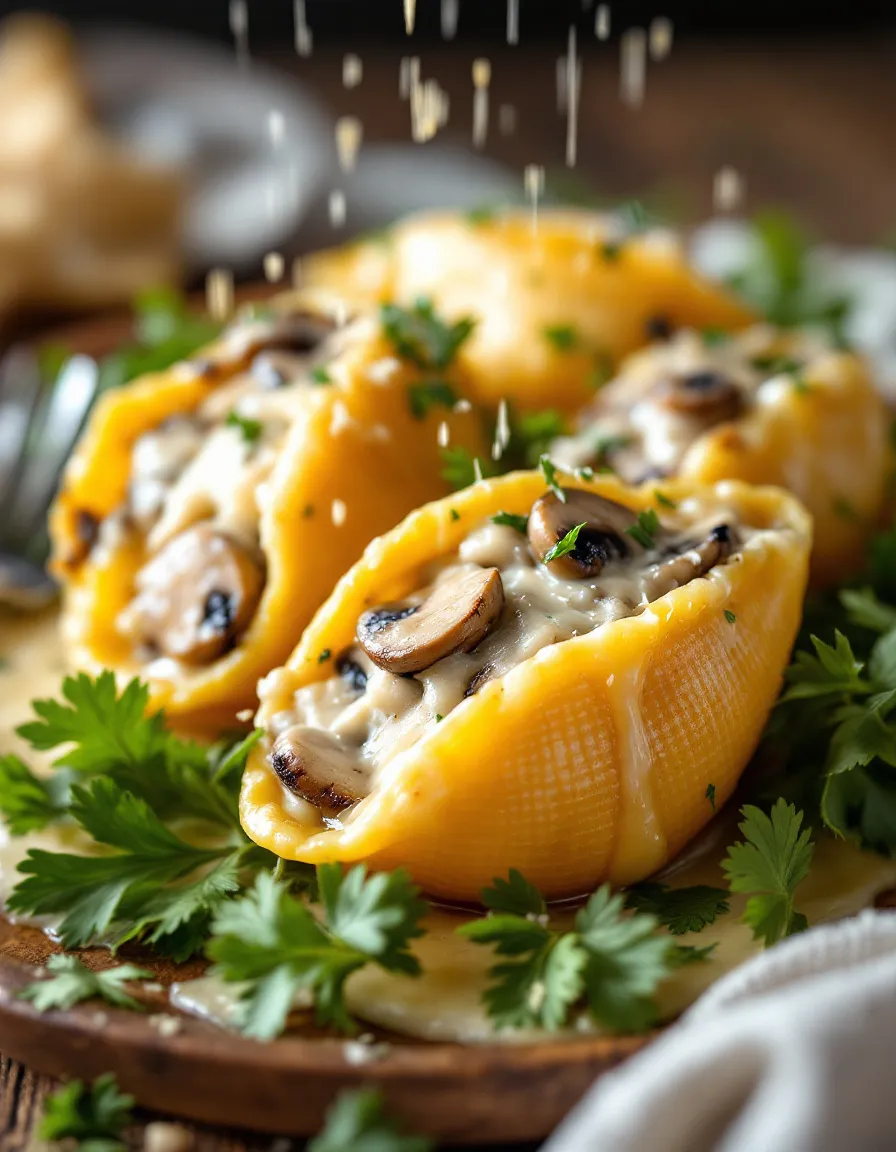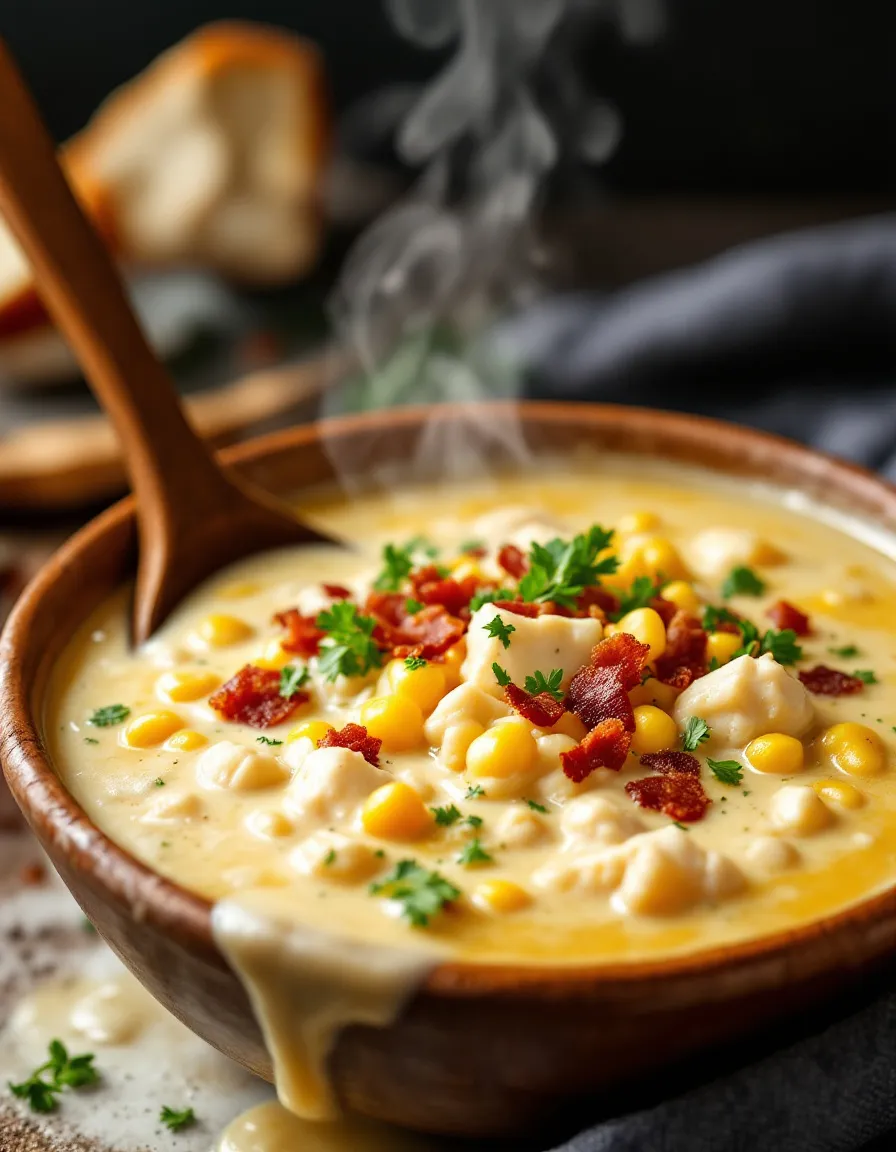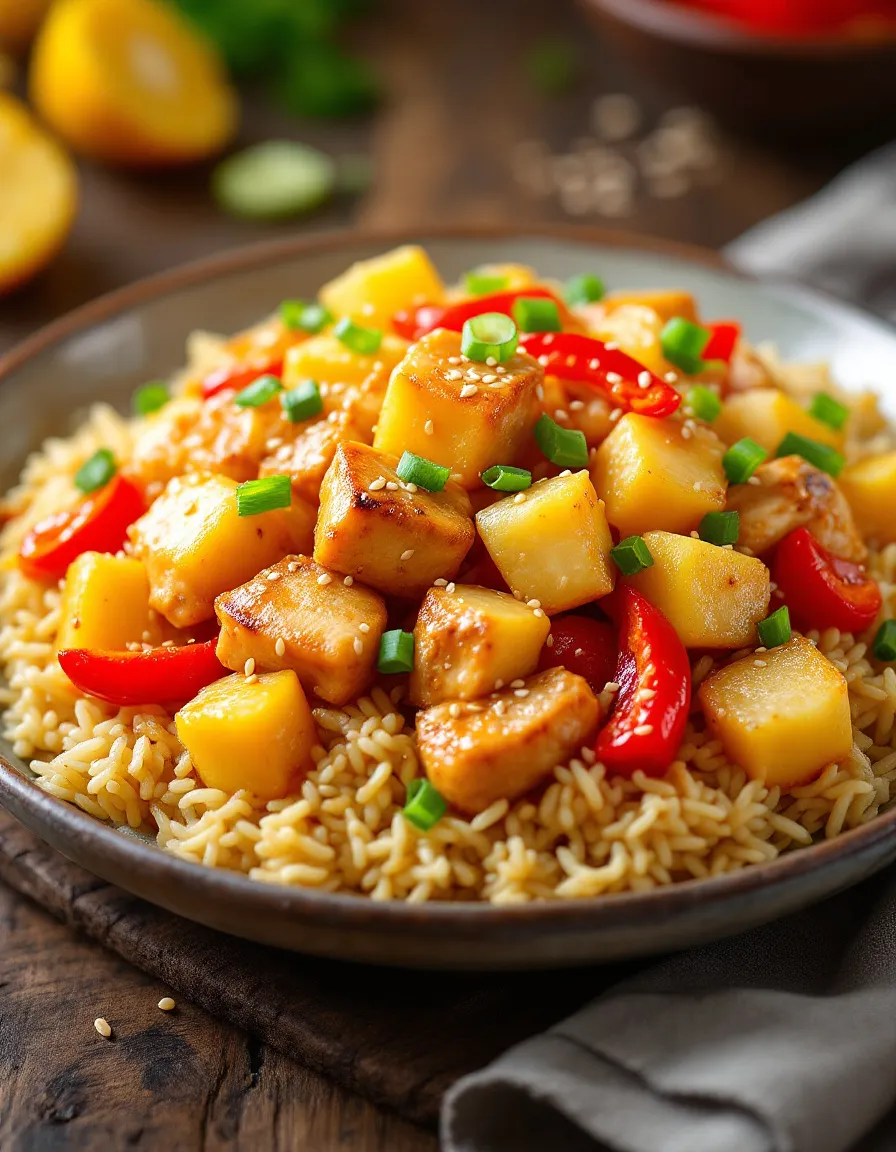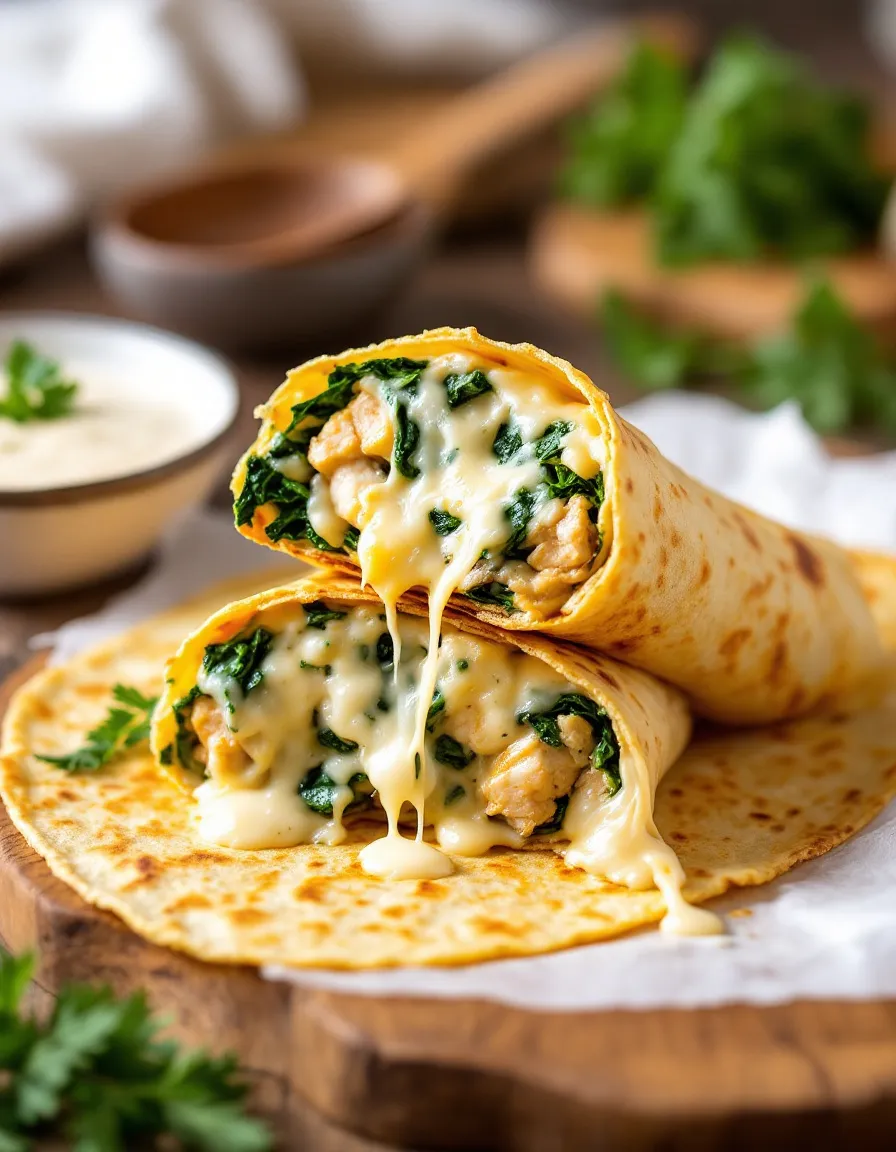Delicious Air Fryer Green Beans: A Healthy Crunch for Every Meal
When it comes to quick side dishes that pack a flavorful punch, Air Fryer Green Beans stand out as a vibrant and healthy choice. Tossed in olive oil, sprinkled with garlic powder, and seasoned with salt and pepper, these green beans emerge from the air fryer perfectly crisp yet tender. With every bite, you can enjoy a delightful crunch that complements any meal, from grilled meats to vegetarian entrees. Easy to prepare and bursting with freshness, this recipe transforms an everyday vegetable into a gourmet experience that your family will love.
As a versatile side, air fryer green beans allow you to customize flavors according to your preferences. Imagine pairing them with zesty lemon juice, spicy red pepper flakes, or even toasted almonds for a nutty twist. The air fryer not only ensures that the beans stay crisp but also reduces the cooking time compared to traditional roasting methods, making it the ultimate go-to meal solution when you’re short on time yet craving something nutritious and tasty.
Quick Recipe Highlights
- Flavor Profile: Savory with a hint of garlic and a touch of salt.
- Texture: Crisp-tender with a satisfying crunch.
- Aroma: Inviting aroma of garlic and roasted vegetables.
- Visual Appeal: Vibrant green color that adds freshness to any plate.
- Skill Level Needed: Perfect for beginners; no special skills required.
- Special Equipment: Requires an air fryer for optimal cooking.
Recipe Overview
- Difficulty Level: This recipe is easy, making it a perfect option for novice cooks. The straightforward steps involve minimal preparation, ensuring success with every attempt.
- Category: This dish falls under quick side dishes, suitable for family dinners or potlucks.
- Cuisine: Rooted in American culinary traditions, this recipe reflects a growing trend of healthy cooking techniques using air fryers.
- Cost: Economical to prepare, using simple ingredients that can be found in any grocery store.
- Season: Ideal for enjoying green beans year-round, especially in spring and summer when they are at their freshest.
- Occasion: Great for weeknight dinners, BBQs, or holiday gatherings. They pair well with a range of main courses.
Why You’ll Love This Recipe
Air fryer green beans deliver an exciting taste and texture combination that elevates the customary vegetable side dish. The balance of flavors, thanks to the seasoning, produces a rich, savory profile that is just irresistible. Moreover, the crispy texture combined with a tender bite creates an appealing mouthfeel that complements various dishes. From family meals to dinner parties, these green beans invite everyone to savor delightful conversations while enjoying their crispiness with each forkful.
The convenience of preparation provides another compelling reason to love this recipe. With a brief prep time and quick cooking in the air fryer, you can have a healthy, delicious side ready in no time. This makes it exceptionally suitable for busy weeknights or last-minute guests. The air fryer simplifies the cooking process, allowing anyone to whip up gourmet-quality dishes without the need for extensive culinary skills.
Nutritionally, air fryer green beans shine as well. Green beans are low in calories and packed with essential vitamins and minerals, including Vitamin C, Vitamin K, and fiber. Preparing them in the air fryer retains their nutrients while adding minimal fat, making them an excellent addition to any health-conscious diet. It’s a delicious way to incorporate vegetables without compromising on taste.
Socially, air fryer green beans make for excellent conversation starters at gatherings. Their bright color and delightful crunch invite guests to enjoy this healthy alternative while engaging in insightful discussions about nutritious eating. The dish not only serves as a delicious side but also endorses a lifestyle that values health and wellness, making it perfect for shared meals.
Last but not least, the cost-effectiveness of air fryer green beans adds to their appeal. Using affordable ingredients, this recipe allows for large portions suitable for feeding families or entertaining larger groups without breaking the bank. The ability to source fresh green beans easily means that anyone can access and enjoy this simple yet tasty dish at home.
Historical Background and Cultural Significance
The history of green beans dates back to ancient Mesoamerican cultures, where they were cultivated for food. Over the centuries, green beans have become a staple in many households across the globe. In the United States, they’re often linked to home cooking traditions, further popularized by their involvement in various seasonal festivities, particularly Thanksgiving, where they are often featured in classic casseroles. The introduction of air frying technology has redefined how we prepare these beloved beans, highlighting their versatility while keeping cooking simple and healthy.
Culturally, green beans hold a place of importance in American cuisine. Their incorporation into everyday meals represents a shift towards healthier dining options, focusing on fresh produce and modern cooking techniques. This object signifies not just sustenance but also connects communities that gather around tables to share meals, stories, and traditions, showcasing their value in bringing people together.
As cooking methods evolved over time, the air fryer emerged as a revolutionary tool, allowing home cooks to recreate the comfort of frying with less oil. This technique has given rise to creative adaptations of classic recipes and opened an opportunity to showcase green beans in a new light. The air fryer promotes the idea of healthier eating, inviting a broader demographic to enjoy vegetables while simplifying preparations.
Regional variations of green beans can be found worldwide, tailored to local flavors and ingredients. For instance, in Southern cuisine, green beans might be cooked with bacon or ham, infusing rich flavors that contrast sharply with the simplicity offered by air frying. These adaptations reflect how culinary practices are influenced by geography and cultural preferences, proving that even a humble vegetable can take on many forms.
Ingredient Deep Dive
Green Beans
Green beans, also known as string beans, have a rich history and are one of the commonly consumed vegetables in many households. Their versatility in different cuisines makes them a staple ingredient. Besides being delicious, they are low in calories and high in fiber, which supports a healthy digestive system. Selecting fresh green beans involves looking for vibrant color and firmness as signs of freshness.
When it comes to storage, you should keep green beans in the refrigerator, ideally in a produce bag to maintain their crispness. They can last about a week when stored properly. If you want to substitute them, consider snap peas or asparagus for a similar crunch and flavor profile.
Olive Oil
Olive oil is a heart-healthy fat packed with antioxidants. It has cultural significance, especially in Mediterranean cuisine, where it is used generously for cooking and dressing. Olive oil helps bring out the flavors of the vegetables and provides a slight richness without overwhelming other ingredients. When selecting olive oil, look for extra virgin varieties for the best quality and flavor.
Storage of olive oil requires keeping it in a cool, dark place to maintain its integrity. If you need substitutions, avocado oil or grapeseed oil works well in similar applications, offering a similar taste without compromising on health benefits.
Garlic Powder
Garlic powder is revered for its flavor-enhancing properties and health benefits, especially in supporting heart health and possessing anti-inflammatory properties. It’s frequently used in kitchens worldwide to elevate the taste of dishes, including our air fryer green beans. When buying garlic powder, ensure you select high-quality brands for a better flavor.
Garlic powder can be stored in a dark, cool place and has a long shelf life. If you need to replace it in a recipe, consider using fresh minced garlic, adjusting the quantity according to personal preference.
Salt and Pepper
Salt enhances flavors, while pepper adds complexity; both are essential in cooking. Their roles are critical in the air fryer green beans recipe, promoting taste and balancing flavors. Sea salt or kosher salt is recommended for seasoning, as they provide a purity of flavor without additives. On the other hand, fresh ground black pepper is advised for the best flavor intensity.
It is essential to store salt in a cool, dry area. You’re welcome to replace table salt with sea salt if needed, as long as measurements are adjusted slightly due to differing grain sizes.
Common Mistakes to Avoid
- Overcrowding the Air Fryer: This can cause uneven cooking, leading to some beans being undercooked while others are overdone. Ensure the beans are arranged in a single layer for the best results.
- Not Preheating the Air Fryer: Skipping this step can affect cooking times and lead to undercooked beans. Preheat the air fryer for consistent temperatures.
- Using Wilting or Old Green Beans: Always check freshness; limp beans won’t yield the same crisp texture.
- Failing to Toss Halfway through Cooking: This promotes even cooking. Skip this step, and you might find some beans crisping while others are soggy.
- Insufficient Seasoning: Season before cooking, but don’t be shy! Green beans benefit from generous seasoning, so add more garlic powder, salt, or pepper as required for flavor.
- Ignoring Cooking Times: Each air fryer model may differ. Always check for doneness and adjust cooking times for your specific unit.
- Using Low-Quality Oil: High-quality olive oil enhances flavor and health benefits. Opt for quality over quantity.
- Not Cleaning the Air Fryer: Residues from previous cooking can affect the taste of your beans. Clean out any debris or prior oils for optimal flavor delivery in your dish.
Essential Techniques
Air Frying: The cornerstone technique for this recipe. Air frying circulates hot air to achieve a crispy texture while using minimal oil. Mastering this method can lead to healthier versions of traditionally fried foods. Avoid overcrowding the basket to ensure optimal air circulation for even cooking.
Seasoning: Proper seasoning ensures that the flavors of your green beans shine. Always season your vegetable base before cooking, allowing the flavors to meld. Pay attention to salt; a little goes a long way. Taste and adjust as necessary for the best outcome.
Pro Tips for Perfect Air Fryer Green Beans
1. Choose fresh, vibrant green beans for maximum flavor and crunch. Look for beans that snap easily and have a bright color.
2. Consider marinating your beans briefly in olive oil and sprinkle with spices for a unique twist. Marinade can introduce extra flavor depths.
3. Experiment with additional seasonings! A dash of red pepper flakes can spice things up, or a sprinkle of parmesan cheese can provide a savory coating.
4. For variations, try adding sliced almonds or sesame seeds just after air frying for added crunch and nutrition.
5. Check the beans frequently towards the end of cooking time. Every air fryer can differ, so adjust according to your appliance.
6. Allow the beans to cool slightly before serving; this helps retain their texture while enhancing flavor.
7. Pair the air fryer green beans with a dipping sauce like ranch or balsamic glaze for added complexity and taste.
8. Lastly, if you want a caramelized flavor, put the beans in the basket for a few minutes longer but watch closely to avoid burning.
Variations and Adaptations
Regional Variations: Different cultures have unique takes on green beans. For example, French-style green beans can be enhanced with shallots and herbs for a different flavor profile.
Seasonal Adaptations: In fall, you can mix in roasted pumpkin or squash for a seasonal touch that adds sweetness and richness to your dish.
Dietary Modifications: For a vegan variant, skip any cheese toppings and load up on veggies while ensuring low-sodium seasonings are used.
Flavor Variations: Develop a Mediterranean feel by integrating feta cheese, sun-dried tomatoes, or kalamata olives, delivering a burst of flavor that transports you through the Mediterranean.
Texture Modifications: Add toasted breadcrumbs after frying for extra crunch and a gourmet finish.
Presentation Alternatives: Serve in a stylish dish with a drizzle of balsamic reduction. The combination of colors and flavors can turn your dish into a centerpiece.
Serving and Presentation Guide
For plating, arrange the air-fried green beans parallel on a serving dish to highlight their vibrant color. Add a sprinkle of fresh herbs such as parsley or thyme for a touch of brightness and flavor. Consider serving with complementary dips like garlic aioli or a squeeze of fresh lemon to elevate the dining experience.
Garnishes not only make the dish visually appealing but can enhance the taste. Lemon wedges or zest can add a refreshing kick that pairs well with the beans. Utilize decorative serving bowls that contrast with the green, such as white or black, to create an eye-catching presentation.
For modern serving suggestions, group air fryer green beans alongside hearty entrees like grilled chicken, or use them as a vibrant addition to a salad. For temperature considerations, serve warm to maintain the optimal texture, as they can become less appealing if left to cool.
Portion control is key; aim for a fist-sized serving of green beans per person to keep servings manageable yet satisfying, allowing guests to enjoy them without overwhelming their plates.
Wine and Beverage Pairing
When it comes to wine pairings, a crisp, dry white wine like Sauvignon Blanc or Pinot Grigio complements the fresh flavors of air-fried green beans beautifully. These wines highlight the vibrant nature of the dish while keeping the palate refreshed.
For non-alcoholic alternatives, consider sparkling water with a splash of lemon or a light herbal iced tea. These drinks provide a refreshing contrast to the savory elements of the green beans. The slight acidity or sweetness of the beverage can enhance your overall dining experience.
If you enjoy coffee, a light roast with citrus notes can work surprisingly well as a unique pairing with your meal. Ensure the coffee is served at the right temperature to avoid overpowering the vegetable dish.
Storage and Shelf Life
Store any leftover air fryer green beans in an airtight container in the refrigerator. They are best consumed within 2 to 3 days for optimal flavor and texture. When storing, separate layers using parchment paper to prevent sogginess.
The best temperature for storage is around 34°F to 40°F to maintain freshness. Always ensure the beans are completely cool before sealing them in a container to prevent moisture buildup. As for reheating, place gradually in the air fryer for about 5 minutes to regain that delightful crispiness.
If you wish to freeze them, consider blanching green beans beforehand. Once cooled, place in a freezer-safe bag and remove air before sealing. They can last up to 6 months, although they are best suited for immediate consumption.
Make Ahead Strategies
For those looking to save time, consider prepping green beans the day before by washing and trimming them. Store in a sealed container with a damp paper towel to keep them crisp. You can season them ahead of time too; just wait to add oil until you’re ready to cook.
After pre-preparation, you can place them in the air fryer from the fridge without needing a longer cooking time. Assess the quality impact; pre-seasoned beans may lose some fresh flavor but will still be delightful once cooked.
If making the dish during a gathering, organize ingredients into labeled bags for quick assembly. This ensures your cooking timeline is seamless, focusing on the assembly rather than individual ingredient prep.
Scaling Instructions
To halve this recipe, simply scale down the ingredients accordingly while keeping the air frying time the same for consistent results. For larger gatherings, you can double or triple the recipe, just be cautious of the air fryer size to avoid overcrowding.
Adjusting the equipment might be necessary; if preparing a large batch, consider air frying in shifts while keeping the first batch warm in the oven at low temperature. Remember, timing may vary, so regularly check on your beans to maintain crispness.
For storing, larger quantities may require more significant containers or multiple bags. Consider portioning leftovers in single-serving sizes for more accessible reheating and enjoyment later on.
Nutritional Deep Dive
Air fryer green beans are a healthy addition to your diet, offering minimal calories with impressive micronutrients. They are particularly rich in fiber, helping promote digestive health while aiding in weight management. A typical serving provides around 30 calories, making it a guilt-free side dish choice.
At a macro level, the dish is low in fat due to the minimal use of olive oil while retaining delightful flavor. In terms of micronutrient analysis, green beans are high in vitamins A and C, essential for skin health and immune support.
In focusing on health benefits, regular consumption of green beans can support heart health due to their potassium content, which aids in regulating blood pressure. They’re suitable for various dietary needs, especially for those looking to maintain healthy weight levels or blood sugar control.
Dietary Adaptations
For a gluten-free option, this recipe naturally fits the bill! Ensure seasonings do not contain gluten, and you can safely enjoy them without worry.
If you prefer a dairy-free dish, skip any cheese toppings and keep it simple with minimal oil and seasonings. This maintains the dish’s healthful nature.
For vegans, air fryer green beans serve as a fantastic side or main component in a meal. Pairing with a protein source like tofu can provide a well-rounded dish.
If you’re following a low-carb or keto diet, these green beans are an excellent vegetable option that enhances your meals without exceeding carbohydrate limits.
Paleo adherents will love this dish, as it features whole, nutrient-dense ingredients aligned with the diet’s principles. Add in hearty nuts to boost healthy fats if desired.
Those on a low-FODMAP diet can indulge in this recipe by monitoring any added ingredients but typically can enjoy them outright.
Troubleshooting Guide
If you encounter texture issues with your green beans, such as them being too soft, consider lowering cooking time next time to preserve their natural crunch. If beans seem overcooked, try adjusting the temperature slightly lower for more control over texture.
If flavor balance seems off, take note of seasonings used in future batches. A little extra salt or acidity from lemon juice can help elevate the profile dramatically.
Temperature problems can arise if the air fryer is not preheated. Be consistent in preheating to the desired temperature before adding the beans to address any undercooking or overcooking concerns.
When facing equipment challenges, familiarize yourself with your air fryer’s settings and ensure you have the right size for your recipe. Every appliance behaves differently.
For ingredient substitutions, use what you have on hand but strive for similar flavor profiles. Fresh garlic, for instance, can replace garlic powder, and while there may be nuances in taste, they won’t detract from the dish.
Recipe Success Stories
Our community love for air fryer green beans continues to grow, with many readers sharing they’ve discovered a new favorite side dish! Recipes that explore different seasonings create excitement, and adaptation stories reflect the variety made possible with simple tweaks.
Readers have reported successful variations, from adding different nuts to experimenting with spice blends, attributing their perfect air fryer green beans to these small modifications.
Photography tips shared by our audience suggest capturing the vibrant green of the beans against a contrasting background to showcase their appetizing appeal. Engaging composition attracts attention and encourages sharing on social media platforms, helping to inspire new culinary enthusiasts.
Frequently Asked Questions
Can I make this recipe with frozen green beans? Yes, you can use frozen green beans, but adjust the cooking time slightly longer as they are initially cold.
How do I know when the green beans are done cooking? They should be bright green and tender with a slight crunch; check them after 10 minutes for doneness.
What dipping sauces pair well with air fryer green beans? Options like garlic aioli, ranch dressing, or even a tangy vinaigrette complement the beans wonderfully.
Is this recipe suitable for meal prep? Absolutely! Store cooked green beans separately and reheat as needed for quick meal integration.
Can I add other vegetables? Yes, adding quick-cooking vegetables such as bell peppers or zucchini can create a colorful medley.
What’s the best way to reheat air fryer green beans? Use the air fryer at a lower temperature for a few minutes to restore crispness without overcooking.
What other seasonings work well? Additional seasonings like cumin, smoked paprika, or Italian herbs can provide a new flavor dimension.
Can I make this recipe ahead of time? You can prepare and season green beans before cooking, and air fry them just before serving.
How do I store leftover green beans? Keep them in an airtight container in the fridge for up to 3 days.
Can I make air fryer green beans without oil? Yes, you can reduce or eliminate oil, but this may affect the crispiness slightly.
Additional Resources
For more inspiration, check our related recipes that feature green vegetables, roasted sides, or quick air fryer meals. Discover techniques around other cooking appliances to maximize your kitchen skills. Dive deeper into ingredient information, showcasing how fresh produce can elevate daily meals, and explore equipment recommendations to find recommendations for the best air fryers available.
Join the Conversation
Engage with us on social media! Share your air fryer green bean creations by tagging us and using our specific hashtags. We want to hear about your variations and personal touches to this beloved recipe. Providing reviews helps others discover great recipes while contributing to a supportive cooking community. Let’s encourage each other to explore culinary creativity and discover new ways to enjoy healthy meals.
The Recipe
Air Fryer Green Beans
Serves: 4 servings
Prep Time: 10 mins
Cook Time: 12 mins
Total Time: 22 mins
Kitchen Equipment Needed
- Air fryer
- Mixing bowl
- Kitchen tongs
Ingredients
- 1 pound fresh green beans, trimmed
- 2 tablespoons olive oil
- 1 teaspoon garlic powder
- Salt and pepper to taste
Directions
- Preheat the air fryer to 400°F (200°C).
- In a mixing bowl, toss the green beans with olive oil, garlic powder, salt, and pepper until evenly coated.
- Arrange the green beans in a single layer in the air fryer basket.
- Cook for 10-12 minutes, shaking the basket halfway through, until crisp-tender.
- Remove from the air fryer and serve immediately.
Recipe Notes
- For added flavor, consider mixing in different herbs or spices as mentioned.
- If you prefer crisper beans, cook them a few minutes longer, checking frequently to avoid burning.
- Can substitute olive oil with avocado oil for an alternate flavor.
